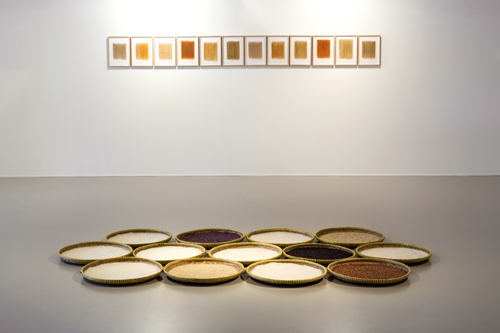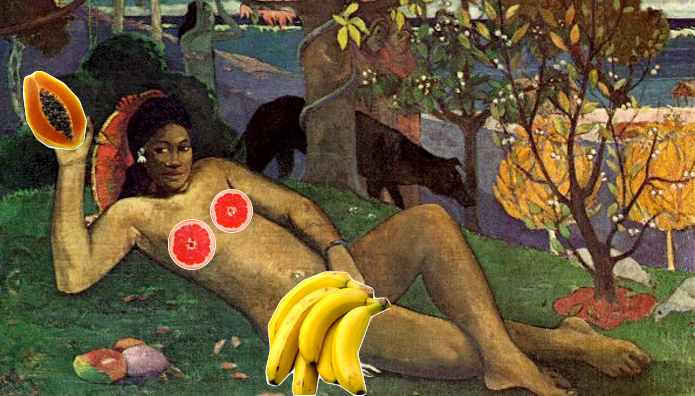 herman de vries - basic values (2016). Foto: Michiel Landeweerd / Framer Framed
herman de vries - basic values (2016). Foto: Michiel Landeweerd / Framer Framed Symposium: Global Art
A symposium held by the AICA (Austrian and Swiss sections) and the Salzburg International Summer Academy of Fine Arts.
Globalisation is generally taken to refer to an economic process. But what does this worldwide development signify for art? Are we at the beginning of a new development, which we might call global art – and what do we understand by this? How far do the new living conditions of
globality influence contemporary art? Since art has been internationally linked for centuries, is there now some new quality that distinguishes global art? How does what we might call global art relate to the debate on post-colonialism?
Globalisation – Globalism
“It is time to re-stage the world”, writes the Indian cultural theorist Nancy Adajania. Her aim is to achieve a state able “to release the cultural self towards others in a manner that bypasses dependency and embraces collaboration, making for a productive cosmopolitanism” (Springerin 1/2010). Thus the objective is a society based on exchange and mutuality.
The basis of this “re-staging” is a critical engagement with globalisation, through a mode that Adajania terms “globalism”. It is a deliberate gesture of recovering the potentialities of the lattices of globalisation from neo-liberal doctrine. To the neo-liberal, globalism refers to a nation-state’s policy of treating the entire world as a market and source of goods and services. To Adajania, on the other hand, globalism is a transcultural, collaborative, multi-participatory
mode of performing ideas and conducting projects, with the emphasis on ethical responsibility and a transformative aesthetics. While neo-liberal globalism is a extension of old first world geo-politics, Adajania’s perspective on globalism shifts the locus to the global South.
Global Art – wish or reality?
For art, globalisation means first of all the end of western hegemony and the beginning of a world trade market. With globalisation, more and more artists enter the global art market, followed by galleries and collectors from a variety of cultures and regions. The influence of
globalisation is beginning to emerge clearly in the themes of the artworks.
When can we speak about global art? Does global art refer generally to
art created no longer from the standpoint of western cultural superiority, but from the experience of globality and under the conditions of globalisation?
Is global art a collective term for works that trace the history of images and their worldwide dissemination – or does it refer to those works, which manage to overcome the long outdated geo-political division of the world into western/non-western? Is the mark of global art a worldwide intelligible visual language, or is it the use of themes concerning globalisation?
Or is global art the wish for and the promise of a multicentric perception of the world, in which local and global are expressly linked, traditions and current developments juxtaposed, and boundaries of cultural hegemony open to discussion? These issues will be debated by theorists and artists to clarify the term and the concepts involved in global art.
Speakers
Nancy Adajania is a cultural theorist, art critic and independent curator, based in Bombay. She is co-artistic director of the 9th Gwangju Biennale, 2012.
Hans Belting, art historian, professor emeritus at the State University of Arts and Design, Karlsruhe.
Bassam El Baroni is a curator and art critic from Alexandria, Egypt. He is the co-founder and director of the non-profit art space Alexandria Contemporary Arts Forum (ACAF).
Monica Juneja holds the Chair of Global Art History at the Cluster of Excellence “Asia and Europe in a Global Context”, University of
Heidelberg.
Jitish Kallat is an artist, based in Mumbai.
Gerardo Mosquera, independent curator, critic and art historian based in Havana. He is artistic director for PHotoEspaña 2011-2013, Madrid.
Senam Okudzeto, artist, writer and activist and the founder of Art in Social Structures, an NGO for cultural education and preservation in Ghana.
Participants in the discussions
Peter Friedl, artist, lives in Berlin. At the 2011 Summer Academy, he is directing the class Pictures as concepts in the Alte Saline Hallein.
Maria Lind, curator and critic, lives in Stockholm. At the 2011 Summer Academy she is directing the class The histories and practices of curating in Hohensalzburg Fortress.
Moderators
Hildegund Amanshauser, art historian, curator, author. Since 2009 director of the Salzburg International Summer Academy of Fine Arts. www.amanshauser.net
Samuel Herzog, born 1966 in Basel. Studied art history in Basel and Bern. Since 2002 editor for visual arts of the Neue Zürcher Zeitung. President of AICA Switzerland.
Sabine B. Vogel, lives in Klosterneuburg, curator and art critic, since 2008 president of AICA Austria.
Simone Wille is an art historian and writer on art, based in Vienna. She regularly writes for English and German publications including the Neue Zurcher Zeitung (NZZ), www.universes-in-universe, Art Nukta.
Program
Friday 29 July
4 p.m. Welcome, Introduction
Hildegund Amanshauser, Sabine B. Vogel
1. Section: what is the history of global art of international
relations between different art worlds and what is global art history?
4.30 p.m. Hans Belting: World art and global art. A new challenge to
art history
5.30 p.m. Monica Juneja: Art history’s new atlas of belonging
6.30 p.m. break
7 p.m. discussion: Hans Belting, Monica Juneja, Peter Friedl
Moderation: Hildegund Amanshauser
Saturday 30 July
2. Section: what is global art? What are new chances? What is the new
quality of global art?
10 a.m. Nancy Adajania: In the age of Babel, the conspectual approach
to global art can only be a vexed ne
11 a.m. Gerardo Mosquera: Beyond anthropophagia: art,
internationalization and cultural dynamics
12 midday Discussion Nancy Adajania, Gerardo Mosquera, Maria Lind
Moderation: Samuel Herzog, Sabine B. Vogel
1 p.m. lunch break
3. Section: what is the relation of global art to regional developments
(global local interdependence)?
3 p.m. Jitish Kallat: GPS coding the imagination: can you tell where
the artist is looking?
4 p.m. Bassam El Baroni: The art that does not make it internationally:
key reasons revealed
5 p.m. break
5.30 p.m. Senam Okudzeto: Art, ego and effectiveness: constructive
challenges for social sculpture in the age of social networking
6.30 p.m. Discussion: Bassam El Baroni, Jitish Kallat, Senam Okudzeto
Moderation: Simone Wille
- SUMMER ACADEMY
Links
Global Art History /
